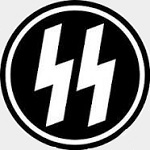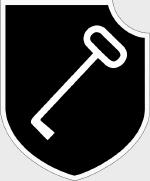Amercom ACBG33 German Flakpanzer 38(t) Anti-Aircraft Gun - 1.SS Panzer Division "LSSAH", Ardennes, 1944 (1:72 Scale)
"We must do everything we can to promote anti-tank defense, and work just as hard to guarantee successful counter-attacks through the instrument of powerful tank forces of our own."
- Major-General Heinz Guderian, "Achtung Panzer!"
 The Flakpanzer 38(t) was designed around the chassis of the Czech-built LT-38 tank and was built from November 1943 to February 1944, entering service in 1944. As the vehicle used the 38(t) Ausf M chassis, the engine was near the middle of the vehicle and the armament was placed at the rear in a specially designed armored section. The upper part folding down to allow 360 degree traverse at low elevation. During World War II, a total of 141 Flakpanzer 38(t)s were built, including the single prototype vehicle.
The Flakpanzer 38(t) was designed around the chassis of the Czech-built LT-38 tank and was built from November 1943 to February 1944, entering service in 1944. As the vehicle used the 38(t) Ausf M chassis, the engine was near the middle of the vehicle and the armament was placed at the rear in a specially designed armored section. The upper part folding down to allow 360 degree traverse at low elevation. During World War II, a total of 141 Flakpanzer 38(t)s were built, including the single prototype vehicle.
The Flakpanzer 38(t) was intended to be issued to the anti-aircraft platoon of each tank battalion (Panzer Abteilung) in a Panzer division.
Most of the Flakpanzer 38(t)s were issued to Panzer Divisions on the Western Front, the remainder served on the Eastern Front. An example user being the 12.SS Panzer Division.
At this late stage in the war, the single 2 cm FlaK main armament was no longer sufficient to ward off enemy aircraft, and the Flakpanzer 38(t) became easy prey for Allied fighter-bombers.
As its folding superstructure allowed a very low elevation the Flakpanzer 38(t) was often used against enemy infantry and unarmored or lightly armored vehicles
Pictured here is a 1:72 scale replica of a German Flakpanzer 38(t) anti-aircraft gun that was attached to the 1.SS Panzer Division "LSSAH", then deployed to the Ardennes Forest during the winter of 1944.
Now in stock!
Dimensions:
Length: 3-1/2-inches
Width: 1-1/2-inches
Release Date: April 2014
 Historical Account: "The Backhand Blow" - SS-Panzer Division Leibstandarte Adolf Hitler (LAH) was formed on March 17th, 1933, by Josef "Sepp" Dietrich, Hitler's bodyguard, on the order of der Fuhrer who wanted a full-time armed force that was completely loyal to him. It was attached to Heeresgruppe Sud during the invasion of Poland and later took part in the invasion of France and the Low Countries. For the most part LAH was held in reserve although it was employed against retreating British troops trapped at Dunkirk. After the British capitulation, it was attached to XIV Armeekorps during the second and final phase of the invasion of France.
Historical Account: "The Backhand Blow" - SS-Panzer Division Leibstandarte Adolf Hitler (LAH) was formed on March 17th, 1933, by Josef "Sepp" Dietrich, Hitler's bodyguard, on the order of der Fuhrer who wanted a full-time armed force that was completely loyal to him. It was attached to Heeresgruppe Sud during the invasion of Poland and later took part in the invasion of France and the Low Countries. For the most part LAH was held in reserve although it was employed against retreating British troops trapped at Dunkirk. After the British capitulation, it was attached to XIV Armeekorps during the second and final phase of the invasion of France.
Following the armistice, LAH was upgraded to a brigade and began training for the planned invasion of Britain (Operation
Seelowe). When the invasion was cancelled, LAH was transferred to Romania for the Balkan invasion.
It fought its way through Yugoslavia and Greece chasing Allied troops to Kalamata, where they were evacuated by sea to Crete. LAH was attached to
Heeresgruppe Sud during the initial stages of Operation Barbarossa, seeing action at Kiev and again at the Black Sea port of Rostov. It was transferred to France for refitting in 1942 and was upgraded again, this time to a Panzergrenadier Division. It returned to the Eastern front the following year, fighting at Kharkov and then at Kursk during Operation Zitadelle. After Kursk, LAH was sent to Italy to perform anti-partisan duties but was soon returned to the Eastern front, this time as a full-fledged Panzer Division. Following the debacle at Kamenets-Podolsk, it was sent to France for rest and refit.
LAH fought in Normandy following the Allied invasion and saw action at Caen, Falaise, and Aachen as it fell back on the German frontier. It participated in the Ardennes counteroffensive (Operation "
Wacht am Rhein") where it was attached to I SS Panzerkorps. Later on, LAH was sent back to the Eastern front to help break the siege of Budapest (Unternehmen Margarethe). Afterwards, it was transferred to Austria where it surrendered to American troops at war's end.


